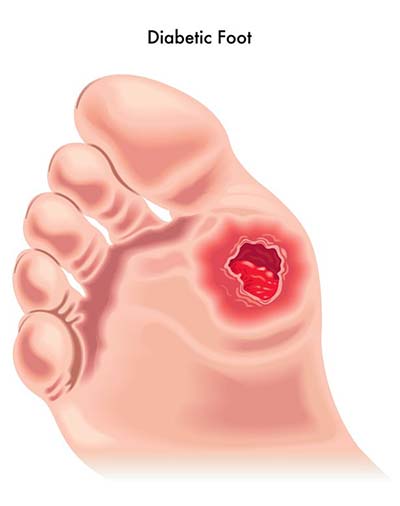40 Ferry St, Newark, NJ 07105 (973) 309-7641
Diabetic Feet
What is it?
 Diabetes is a disorder that affects many people in our society. Diabetes mellitus is a condition in which the body is unable to transport sugar from the blood to the cells. People who suffer from this disease cannot produce or use insulin, which is necessary to keep the sugar under control. Many sufferers of this disease will complain of constantly being thirsty, hungry, and frequently having to urinate. Diabetic patients often have problems with their circulation, which can result in foot pain, and problems. If this disease is not identified and goes untreated, it can lead to severe health issues and occasionally death. This disease process can affect your kidneys, eyes, sense of feeling in your feet and the circulation to the foot.
Diabetes is a disorder that affects many people in our society. Diabetes mellitus is a condition in which the body is unable to transport sugar from the blood to the cells. People who suffer from this disease cannot produce or use insulin, which is necessary to keep the sugar under control. Many sufferers of this disease will complain of constantly being thirsty, hungry, and frequently having to urinate. Diabetic patients often have problems with their circulation, which can result in foot pain, and problems. If this disease is not identified and goes untreated, it can lead to severe health issues and occasionally death. This disease process can affect your kidneys, eyes, sense of feeling in your feet and the circulation to the foot.
What causes it?
Diabetes mellitus can be caused by a number of factors. If there is a family history of diabetes, one's chances of developing this disorder significantly increases. Over weight people are also at risk, since the body is in a constant battle with the elevated sugar. As one gets older, a certain type of diabetes, ¬type II (non-insulin dependent) becomes prevalent. On the other hand, type I diabetes (insulin dependent), is more prevalent in the young. African Americans and Hispanics are also more susceptible to this disease. If any of the above facts apply to you, an evaluation visit to your family doctor is suggested.
How do you treat it?
The effective treatment of diabetes mellitus begins with patient cooperation and compliance. The patient needs to understand that this disease can be severe and that a strict diet as well as faithful use of all medication is necessary to keep this disease under control. Some patients may need to inject insulin while others might need to take various oral medications. Careful monitoring of one's blood sugar on a daily basis is essential since it will give both the patient and doctor an idea of how well the sugar is controlled. Periodic trips to your foot doctor are also needed. Many diabetics have problems with their feet and if regular monitoring is not followed, subsequent complications can readily occur. Active ongoing patient participation is an essential aspect in the clinical management of this disease.
Diabetic Periodic Care
It is essential to thoroughly evaluate and periodically manage the diabetic patient. We know that diabetics can specifically have impaired circulation, reduced sensation, and a greater tendency to develop infections, ulcerations and other skin problems. Early detection, periodic monitoring, and judicious care are essential in the prevention and management of diabetic complications. The lower legs and feet are primary locations for these problems to occur. Professional care and supervision can be highly effective in minimizing the complication tendencies of patients with diabetes.
Periodic care for these patients can range from a simple examination of one's feet to more involved treatments of such problems as diabetic arthropathy (diabetic arthritis), peripheral neuropathy (loss of feeling), vascular complications, and ulcerations. The podiatrist will examine the feet to make sure that there is adequate blood supply and sensation (feeling) to the feet. A decrease or loss in one or both can lead to infection and potentially more serious problems. In many cases, the podiatrist will involve by referral, other medical specialists to participate in the total team approach to managing the existing diabetic problems.
Many diabetics are seen by their foot specialists on a periodic basis for general foot care. It is important to keep the nails properly trimmed so that they do not become ingrown and cause infection. This is important as many diabetics can not fight infections as well as people without the disease. Also, the skin of diabetic patients is thinner and more susceptible to injury than that of non-diabetic persons. It is important to reduce the calluses to relieve pressure over the bony prominences of the feet. If there is too much callus build-up, the skin may break down and lead to an ulceration. An ulceration can become infected and possibly lead to more serious consequences requiring more involved care.
